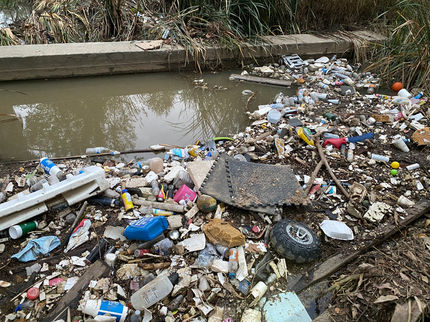New magnetic carbon composites for biological and environmental applications
Scientists at Leibniz Institute for Agricultural Engineering in Potsdam and Humboldt University Berlin developed a simple process for direct synthesis of magnetic carbon composites through hydrotherma
Advertisement
Scientists at Leibniz Institute for Agricultural Engineering in Potsdam and Humboldt University Berlin developed a simple process for direct synthesis of magnetic carbon composites through hydrothermal carbonization (HTC) and demonstrated their useful application in biogas production. The carbon particles have a moderate surface area and, as a novelty, a magnetic core. This unique combination opens the door for various applications including fixation of microbial biomass or removal of problematic substances in bioprocesses, wastewaters or the environment.
Anaerobic biological processes like biogas production are limited in their performance and usability due to slow microbial growth and inhibition effects by several chemical compounds such as ammonium. Until today, common techniques for the accumulation of microorganisms in a biogas reactor are usually based on their retention through sedimentation or installations inside the reactor, on which the microflora can settle and form biofilms. However, both require a low-solid fermentation liquor. In biogas reactors fed with solid feedstocks such as manure or maize silage the viscosity is often too high.
In a new approach to improve efficiency of the biogas process, scientists of the Leibniz Institute for Agricultural Engineering in Potsdam (ATB) and Humboldt University Berlin use biochar – more precisely: magnetic carbon composites.
Biochar is a carbon and surface-rich material. Like charcoal, biochar is obtained by thermo-chemical conversion of biomass, which includes the use of digestate from biogas plants. Biochar can be produced by different techniques. A process with a particular flexibility is the hydrothermal carbonization (HTC). HTC is performed in a pressure cooker-like reactor in presence of water and the biomass is via various intermediate steps converted into carbon products with distinct properties. Because of their high biological stability and high sorption capacity for water and nutrients, biochars are considered as an additive for soil amendment and carbon sequestration. In addition, various other applications of biochar e.g., wastewater cleaning or catalysis of biological and chemical processes are under investigation.
In their article, recently published in the journal „Bioresource Technology“, the researchers report about the hydrothermal production of magnetic carbon composites and their successful colonization by biogas microorganisms in laboratory tests.
“Our results clearly indicate that HTC is an adequate technique for producing stable magnetic carbon composites which, for example, qualify as support media for functional microorganisms. These composites can be retained in the biogas process by magnetic forces and thus lead to a higher concentration of active microorganisms in the biogas reactor”, underlines project leader Dr. Jan Mumme. “Anaerobic microorganisms are more tolerant of environmental threats and achieve higher synergistic performance when in form of a biofilm instead of free-living cells”, adds Patrice Ramm, who works on magnetic retention in anaerobic digestion in scope of his PhD thesis.
Main advantages of new carbon-based method are the simple production of magnetic composites at relatively low temperatures, the use of abundantly available organic materials (e.g. waste biomass) and the high flexibility of the composites in terms of their functionality and morphology.
The new magnetic composites were produced from microcrystalline cellulose and the mag-netic compound “ferrite” at 250°C in a HTC pressure reactor. Microscopic images revealed an amorphous carbon layer growing on the 30-80 µm ferrite particles. The ferrite’s magnetic properties sustained the HTC process unchanged. As a result, composite particles with carbon structures on a magnetic core were obtained. With 0.88 m2/g, the surface area of the new material was similar to the raw cellulose but considerably lower than non-magnetic cellulose-derived hydrochar (21.2 m2/g).
In the next step, the composites were tested over 158 days in laboratory-scale fermentation trials for their impact on biogas production (beet silage served as feedstock). For comparison purposes, a non-magnetic hydrochar, a zeolite as a long-established biogas additive, and a control without any additive were investigated parallel to the magnetic composite. At the beginning, both carbon products showed inhibitory effects on the biogas process, which however, declined rapidly. In the end, the magnetic composites achieved a methane yield of 93 L per kg of beet silage, which was higher but not significantly higher than all other treatments. Microscopic analyses confirmed microbial inhabitation of the magnetic particles as desired.
Dr. Rainer Tölle from Humboldt University Berlin, long-term experienced in detection of magnetic properties in various materials from the environment and technical processes, has developed a new analyzer for determination of the magnetic susceptibility. This device was used in the present study to assess magnetic properties of the composites. “The magnetic susceptibility is a material property, which allows fast and nondestructive measuring. The parameter describes the attractive force between the sample and a magnet. Under certain conditions, it can also be used as an indicator for the content of heavy metals in the sample”, describes the scientist.
Original publication
Reza, M. T., Rottler, E., Tölle, R., Werner, M., Ramm, P., Mumme, J.; "Production, characterization, and biogas application of magnetic hydrochar from cellulose."; Bioresource Technology 2015.
Mumme, J., Srocke, F., Heeg, K., Werner, M.; "Use of biochars in anaerobic digestion."; Bioresource Technology 164, 189-197, 2014.
Ramm, P., Jost, C., Neitmann, E., Sohling, U., Menhorn, O., Weinberger, K., Mumme, J., Linke, B.,; "Magnetic biofilm carriers – the use of novel magnetic foam glass particles in anaerobic digestion of sugar beet."; Journal of Renewable Energy 2014.



























































